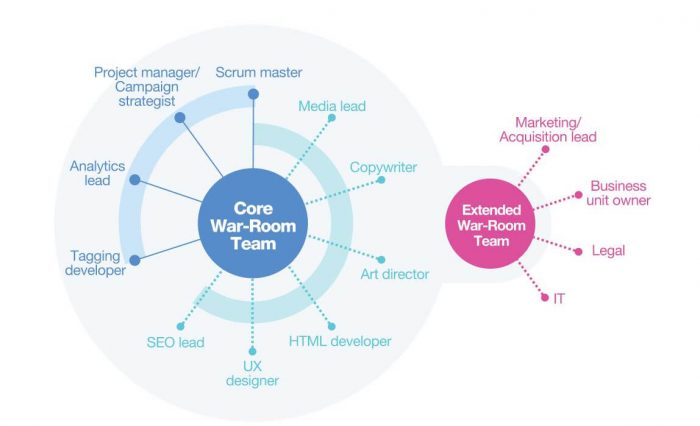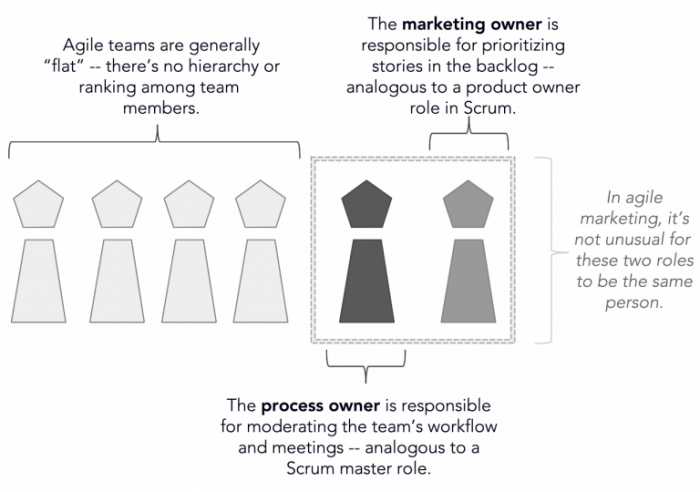The project management paradigm is ruled by Agile Methodology. Anything Agile is widely accepted in the market with open arms and whoever goes against it, is more than likely to suffer business failure. Why is that so? Because through Agile, departments enjoy rapid growth in the satisfaction levels of the teams and also an increase in productivity no matter what the external fluctuations are.
That’s why when the term Agile marketing is coined in the market, it’s accepted with enthusiasm all over the market.
Agile marketing is a marketing strategy that enables the teams to track and fixate upon the most important and profitable projects for the business. Upon doing that, they complete all of these projects, measure the impact of all of those projects on the business, and improve those results over and over again.
In this article, we will tell you all about Agile marketing, e.g. the proper definition as well as highlight all of the important aspects and successes that you can gain through the use of Agile Marketing.
Detailed Explanation of Agile Marketing

Agile marketing at its core is a marketing approach that teams use to highlight all of the profitable and important projects that can bring high value to the company so that they can focus on these projects and generate high yield results.
Teams that are involved in the process use an approach called a ‘sprint’ which is a short but high productivity boost of work-time, that enables them to complete those products quickly and effectively without wasting any time.
After each boost of work-time or sprint, they measure the impacts of all of these high yield projects on the business so that they can increase this productivity and gain tangible results like this over and over again.
Using Agile Marketing, Agile teams can also find out what the low-yield projects are so that the team doesn’t waste a single second of their precious time on these projects.
But even if they did perform a project that turned out to be a dud, they still consider it a win because that mistake won’t happen again.
Agile marketing is a very open approach that openly embraces all of the challenges and failures it faces, as long as these failures teach the teams a lesson and make them stronger to track and tackle only high-yield projects in the future.
You get to know how Agile teams work in the market when you study all of the aspects and factors involved in the Agile marketing paradigm. These aspects are:
- Instead of sticking to the plan, the team responds to all of the changes along the way
- Instead of conventions and opinions, the team indulges in data gathering and testing
- Instead of heading over to large markets, the team sticks to interactions with individuals
- Choosing Big-bang campaigns and instances over rapidly changing iterations
- Instead of relying on a few big bets, the team sticks to all of the small experiments that they have done so far
- Choosing collaboration over silos and hierarchy
In this article, you will notice that we will be focusing more on the tactics of marketing rather than the strategy.
Don’t take us wrong, you should have an overarching strategy for your marketing activities to underpin all of your Agile methods, but the strategy should be the core focus of every marketing department regardless of what their implementation methodology is.
It doesn’t matter if you are using a top-down methodology to create your marketing strategy or you’re using a collaborative methodology, you can always make it shine using Agile techniques.
Further reading:
Agile Best Practices Every Agile Team Should Have in Place
What are the Key Pieces to Implement the Agile Marketing strategy?

Every company is different. They all have marketing departments that make their marketing strategies. But regardless of the company or their marketing department, the following features will be present in any Agile marketing strategy that the team creates. They are:
- Stand-up Meetings: This is a very common practice in the organizational paradigm. Stand-ups are the recurring meetings in which all of the team members are gathered to briefly discuss what’s happening in the project. The optimum time for a stand-up to last is 15 minutes at the very maximum.
In this meeting, all of the team members share the work they are going to do that day regarding the specific project being worked on by the team. They also discuss all of the obstacles that they are facing and these obstacles are addressed by the whole team quickly. - Sprints: Sprints are another important work-time strategy that is heavily used in the organizational paradigm. They are short bursts of heavy productivity in which the manager requires the team to finish all of the activities regarding a particular project.
Typically, sprints last between two to six weeks, depending on the size of the project and the team tackling the development.
Some of the bigger projects that the company has undertaken don’t fit in one sprint, so you as a manager, have to break up the work into short pieces that your team can finish sprint by sprint. - One White Board to Rule Them All: This strategy is also heavily used in the organizational paradigm regardless of the genre of the business and is also an old one.
This is the manager and the team members collectively tracking the activities regarding the project in question.
They usually use a whiteboard or sticky notes or even a software that can keep track of all of those activities like Trello or something much sophisticated (totally up to the manager).
You just have to make sure that whatever board, notes, or application you use to track the activities, all of the team should have access to that so they can also keep track of their productivity and effectiveness.
- Teamwork: If you are a manager of a project under development, that is being worked on using Agile methodologies, you might think that you have complete control over the project.
But you need to understand one thing and you must do which is that the success of the project depends on the teamwork of the entire team and not a single individual breaking their back.
If you are using Agile, then your team must be prepared to collaborate fully with their peers.
What is an Agile Marketing Department Capable of?

Source: Agile Sherpas
By following the below-described methods, your marketing department will be able to tackle all of the obstacles that come before them in the market, so that they can easily reach their targeted audience and accomplish all of the goals and milestones they set for themselves.
Agile Marketing enables the team to:
- Respond swiftly to all of the changes that happen in the market
- Testing a lot of different strategies and choose the ones that benefit the most
- Justify choices in campaigns and projects with hard data
- Produce rapid campaigns that can be tested and optimized over time
- Use input from other departments to augment marketing efforts
- Collaborate with team members to prevent a tunnel-vision approach to marketing
You should keep in mind that this list is a simple version, and is quite brief and to the point. And if you want your strategy to be more specific by taking a look at all of the possibilities on a sprint by sprint or project by project criteria, the list never ends.
How does an Agile Marketing Team Scale across the Organization and Achieve Results?

Forming a badass Agile marketing team is the first goal that you as a manager have to accomplish. But your work doesn’t stop here. To make sure that the results are perfect every time, you need the whole organization to be working in an agile way.
Treading on this strategy requires you to invest all of your major chunks of time and resources into it so that you can properly incorporate the Agile strategies into your company’s mainframe.
The first step to it is to build solid credibility. As the dedicated agile marketing team works on the tracking and testing of the projects, the results from the agile practices that you incorporated would start to propagate throughout the organization.
For every test that presents a successful result, the marketing team can forecast the impact it will have on the business and provides a thorough briefing to the organization so that they can produce a series of rules and regulations throughout the company to control the development process and achieve these results over and over again.
As the projects and the company grows, they mostly invest in more and more Agile marketing teams. Each team focussing on a specific service, goal, or product that they have to the product according to the business goals forecasted by the upper management of the company.
A healthy strategy is to add more agile teams when all of the previous ones are functioning at their optimum capacity. When the number of teams increases and their capabilities enhance exponentially, they begin to expand their horizons and their focus points.
This will help them establish business rules and execute them according to the situations that they face.
Examples of Instances where Agile Marketing is a Gem to have
Ramped Up Content Production

Content production is a vital part of the marketing team. They have to have the largest and most effective library of content on hand if they want to leave a mark in the market. But without Agile practices incorporated in the content production process, the content creation moves at a much slower pace.
This causes the marketing department to disfunction and causes the business a lot of failures.
With Agile practices incorporated in the mix, the team can easily measure the capability of their team in terms of content production. This will help them be more prepared during each sprint and will play at the strength of their team in terms of production and distribution of content.
Accountability of Everyone involved and the Team’s Ability to Swarm any Obstacle that Comes Forward

Every functional and productive team has to have a daily stand-up meeting as a morning ritual. This meeting helps all of the team members to gather and discuss their progress regarding the project at hand.
During this meeting, the team members most importantly discuss any and every obstacle that has troubled them. These issues can be internal or external and an effective team has a special ability in its quiver and that is swarming the obstacle so that it doesn’t endanger the project anymore.
This means that everything related to the project has to be on time. No email can be left unchecked and no team member can be absent without prior notice. Everything and everyone has to be on their A-game to tackle all of the issues related to the project.
All of this is possible only when every team member is up to date on everything related to the project so that they can track their and everyone else’s project and make sure that the project is a definite success.
Conclusion
From this article, you must have deduced that the world of Agile marketing is easily tame-able and you don’t have to push yourself to the limits to produce results, but you’ll be wrong.
Agile marketing is not a quick fix that can heal your damaged marketing strategies or faulty projects all of a sudden. It is a deep and complex methodology whose ins and outs must be learned to be successful.
But rest assured, that when you do learn those ins and outs, Agile marketing is at a whole different level than the other marketing strategies that you might have used in the past.

